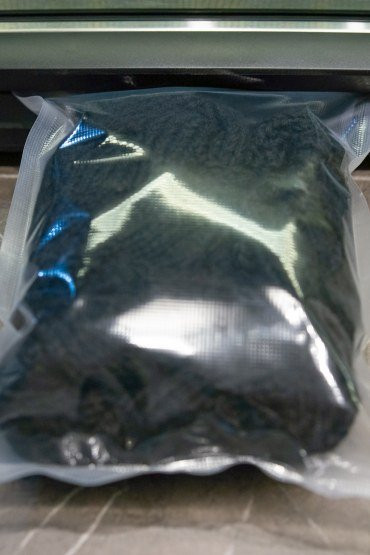A vacuum cleaner is a very useful and, in some cases, an integral tool in the household. The question of its value is beyond doubt both among us and among the majority of active users of kitchen appliances. Vacuum sealing not only significantly extends the shelf life of food, but also provides optimal packaging for sous vide cooking, reduces storage space and prevents juice leaks from juicy foods. Just imagine a bag in a car where kebab or fresh herring was carried.
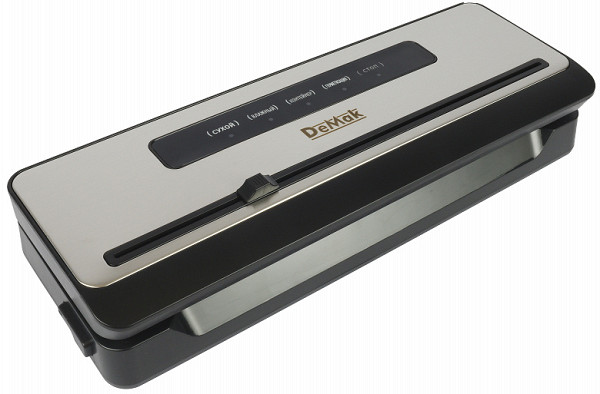
Let's take a look at the DeMak VS8001 vacuum cleaner today — a device that stands out for its excellent price-quality ratio. Its cost is currently quite reasonable, providing the user with all the necessary functions in a durable and stylish case, with a guarantee of up to 3 years. Sounds attractive, all that remains is to check.
Characteristics
| Manufacturer | DeMak |
|---|---|
| Model | VS8001 |
| Type | vacuum packing machine |
| Country of Origin | China |
| Guarantee | up to 3 years |
| Power | 100 W |
| Degree of vacuum (vacuum) | 0.6 bar |
| Type | horizontal |
| Control | mechanical |
| Number of operating modes | 5 |
| Housing material | metal, plastic |
| Sealing length | up to 32 cm |
| Film cutter | There is |
| Weight | 1.2 kg |
| Dimensions (W×H×D) | 38.5×7×13 cm |
| Network cable length | 110 cm |
Equipment
The vacuum cleaner arrived to us in a glossy rectangular package. Most of the front side of the packaging is occupied by a bright image of the device itself and the products packaged with its help, with the name in English next to it. The side faces provide more detailed information listing the technical characteristics of the device.

Inside, the vacuum sealer was sandwiched with foam inserts, and the top panel of the device itself was covered with a thin blue film that protected the body from scratches and dirt.
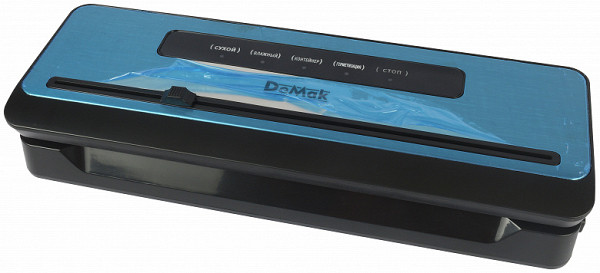
The kit includes: a vacuum cleaner, a power cord, a hose for pumping air out of containers, 15 bags, instructions and a warranty card.
At first sight
The vacuumizer body is mainly made of black matte plastic. In the middle of the lower part of the lid, which is beveled for easy opening, the coating is glossy.
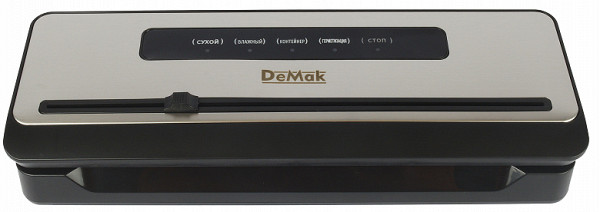
On the top panel there is a stainless steel insert. Thanks to its sleek design and rounded edges, the device looks modern and neat.
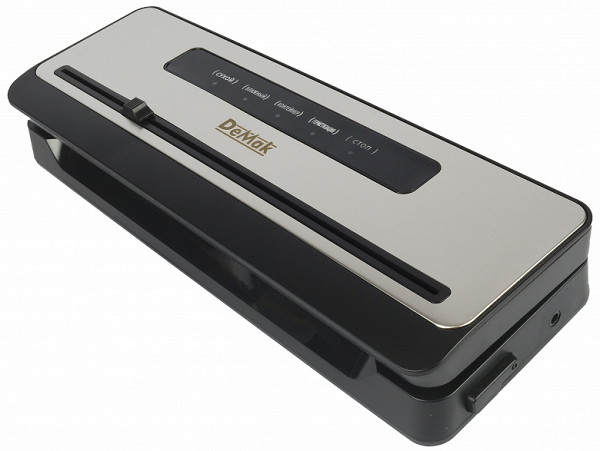
The device weighs 1175 g. Its width is 38.5 cm, its height is 7 cm, and its depth is 13 cm.
Mechanical control buttons are hidden under a matte black plastic insert. Each button has its own indicator and is labeled in Russian. However, the quality of execution of these signatures somewhat detracts from the overall impression of the stylish case.

We pay attention to the font, differences in letter spacing, and some upward movement of the two outer words on the right side. Moreover, the last of these words is distinctly paler in comparison with the rest of the text. For perfectionists, this can cause some discomfort.
Below, covered with matte paint that is rough to the touch, is the company logo. Towards the outer edge there is a built-in cutter with a plastic slider. The length of the cutting hole is 32.5 cm.
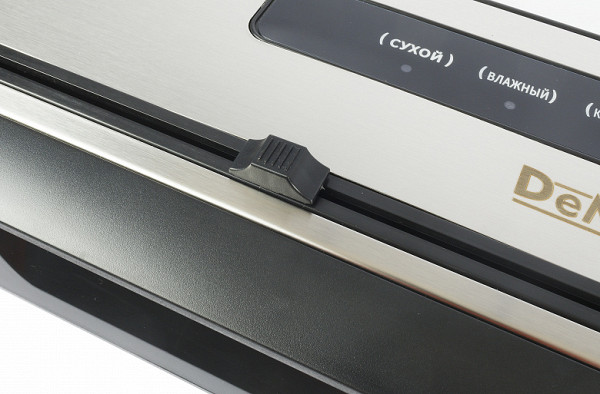
Closing the lid requires moderate force, achieved by pressing on it with corner points until a characteristic click appears. To open the lid, you need to press two large buttons on the sides of the device. Next to the right button there is a socket for connecting a hose for pumping air out of the container.
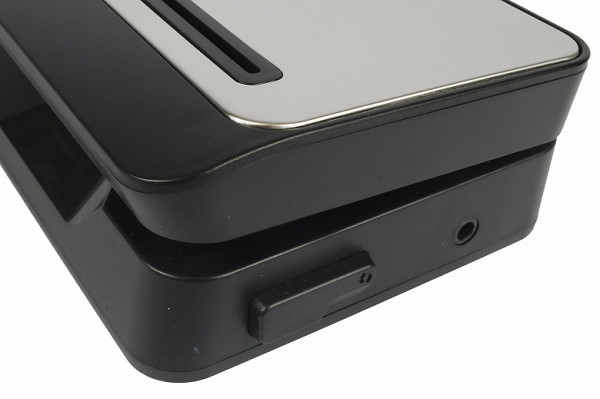
The silicone hose for working with containers is equipped with two connectors.
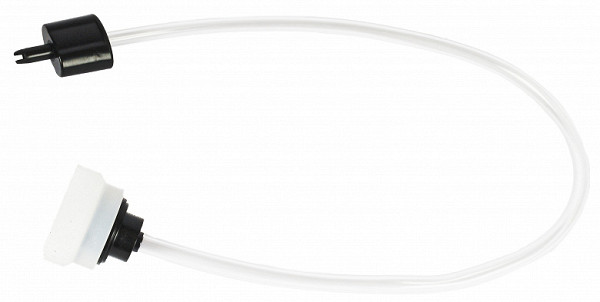
We open the lid and see: a vacuum chamber with a removable tray for collecting liquid, covering the pump fittings and two removable foam seals.
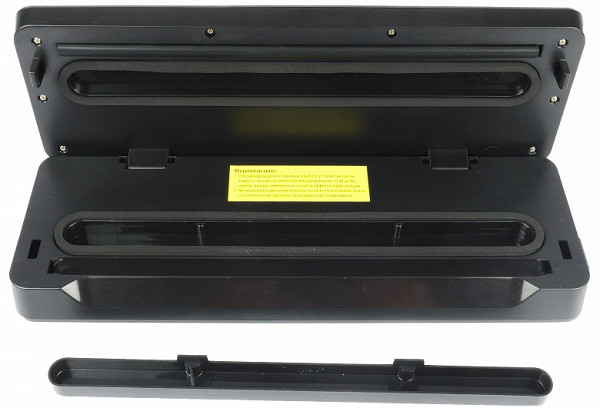
A metal heating element, hidden under Teflon tape, runs close to the outer edge. Directly above it, on the lid, there is a silicone sealing strip that ensures a tight seal. If necessary, this part can be removed. There is a bright warning sticker on the bottom. The width of the thermal tape is almost 32 cm.

There is a nameplate with technical information glued to the bottom of the device in the middle, and legs with anti-slip pads are located in the corners.
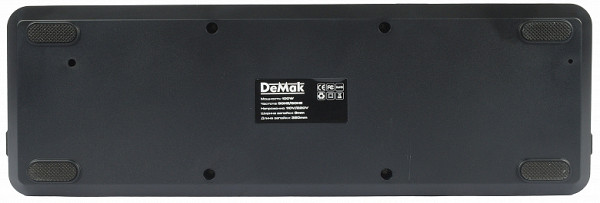
On the back there is a connector for connecting a 110 cm long power cord.
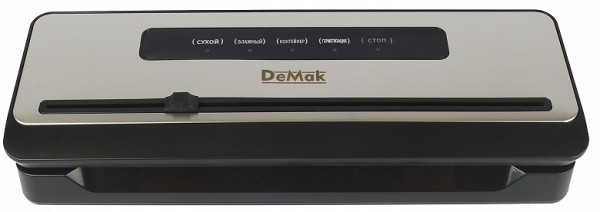

The vacuumizer is equipped with a set of bags measuring 19.5x25 cm. The bags are made of dense polyethylene, one side is flat, the other is corrugated.

The assembly of the DeMak VS8001 vacuum cleaner is neat — we did not find any defects during visual inspection. The device looks good.
Instructions
The user manual for the vacuum cleaner is presented in the form of a narrow A5 brochure printed on high-quality glossy paper. The document includes many color photographs showing the correct use of the device, as well as detailed descriptions of its operation and control principles.

The text in the instructions is simple and clear, making it easy to understand. On the back cover of the brochure there is a QR code that leads to the company's official website. After filling out a special form using this link within 14 days of purchase, you can extend the warranty period to 3 years.
Control
There are 5 buttons on the control panel: for vacuuming dry products, wet ones, for pumping air out of the container, for sealing a bag without pumping out air and for stopping the process.

During operation, the button for the selected mode is illuminated with a blue indicator. The vacuumization process is carried out as follows: place the bag of products with the corrugated side down in the chamber of the device, snap the lid, select the Dry, Wet or Container mode and wait about 10-25 seconds. The device pumps out air, the mode indicator turns off, and the Stop button lights up.

More precisely, it will blink, which will mean that sealing is in progress. After about 5 seconds, the indicator will start to burn steadily — the vacuuming has ended, you can open the lid and take out the bag.
Exploitation
Before you start using the vacuumizer, you just need to unpack the device, place it on a flat surface, connect it to the power supply, and you can get to work.
In this model, the difference between dry and wet modes lies in the speed of air pumping. Wet mode is used more gently when working with contents that contain moisture.
It is impossible to vacuum completely liquid products, except when the device is installed on the edge of the table, and the bag is supported by weight and sealed in your hands.
The model does not have a pulse mode. When packaging juice products, you can select the Wet mode and, when the liquid begins to rise through the bag, press the Stop button and then Press the Sealing button. The main thing is a prompt response. If liquid gets into the chamber, a special container will collect it in a moderate volume. If liquid spills outside the container, it may get into the pump fittings.
Also, when working with products that cannot tolerate excessive pressure, you can manually interrupt the process and perform sealing. During testing, it was found that the vacuum sealer does not exert excessive pressure on delicate products, provided they are carefully placed in the bag.
For effective vacuuming, the bag should be filled to no more than two-thirds of its volume. This applies to both dry and wet foods.
To form the bottom of a bag from a roll of film, we first cut it using the built-in cutter, and then seal it in the “Sealing” mode. The cutter has good cutting ability, doesn't get stuck, and is generally a convenience thanks to what's built into the device.
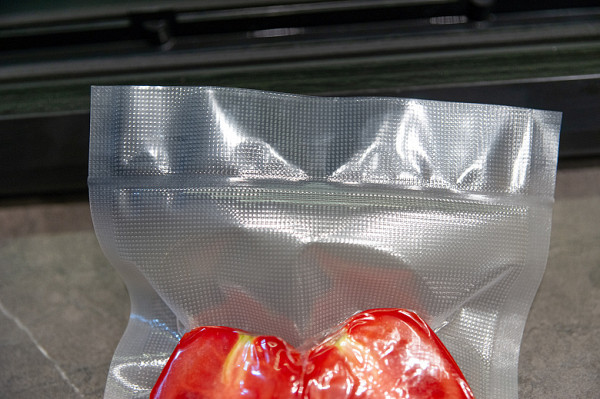
The 4 mm wide seam is perfect, even and very strong. During all this time, it never opened on its own and when I tried to tear it with my hands, it did not give in.
It is important to remember that sealing will not occur if the edges of the bag remain wet. Therefore, it is necessary to constantly monitor the cleanliness and dryness of the edges of the bag. If the edges of the bag get dirty when placing food, just wipe them with a paper napkin.
To pump air out of a special container, you need to connect a hose to the vacuumizer body. However, this may require considerable effort, since the connector is inserted into the vacuum sealer extremely tightly. Then we place the products in the container, not forgetting to leave some free space on top.
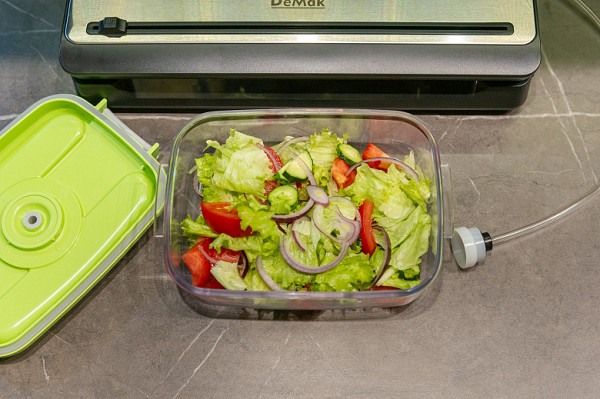
Snap the lid of the container and connect the second end of the hose.
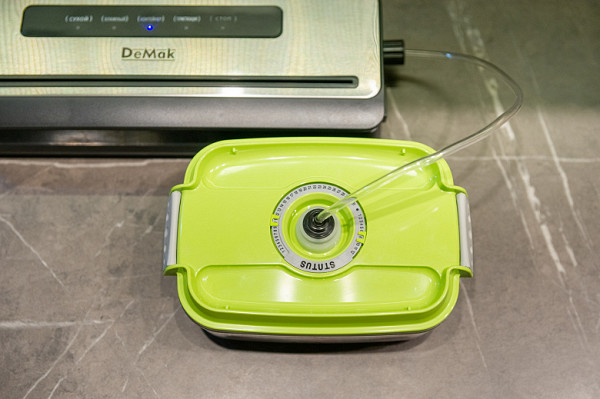
Then we snap the lid of the vacuum sealer and press the Container button. Pumping air in this mode takes an average of 15 seconds.
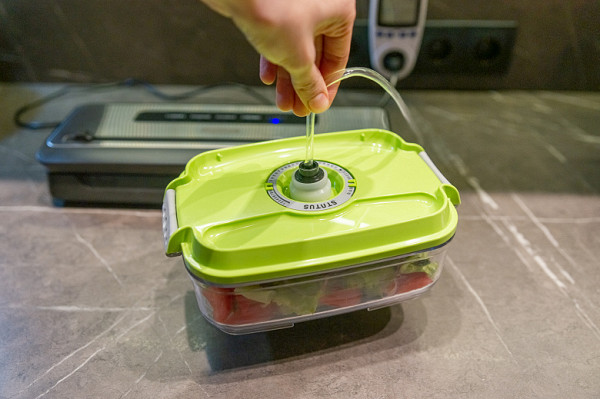
Next, open the lid of the device, disconnect the hose from the container, and then from the vacuum cleaner. Ready.
Care
The vacuumizer body can be easily cleaned by wiping it with a dry or damp cloth. The seals and container for collecting liquid, if necessary, can be removed and washed with water.
When storing the vacuumizer, it is important not to keep the lid latched to avoid deformation of the seals under the influence of constant pressure.
Our measurements
The maximum energy consumption in the process of vacuum sealing food and items in packaged bags was recorded at 99.6 W. During pumping air from the container, the maximum energy consumption was 7.9 W.
Practice tests
Tomatoes
First, we tested the delicacy of squeezing juicy products. The main thing is to leave minimal space between the fruits, then everything will turn out great and their shape will not change.

If you arrange the food in a bag in a disorderly manner, individual fruits may be squeezed and some of the juice may leak out, but they will still not turn into mush.
When vacuum sealing juicy foods, it is recommended to monitor the process to ensure that the liquid does not rise to the top and leak into the chamber. If this effect occurs, the process should be stopped immediately and the bag sealed. In the case of our tomatoes, the liquid did not rise to the top, so we just watched — just about 15 seconds, and the bag was ready.
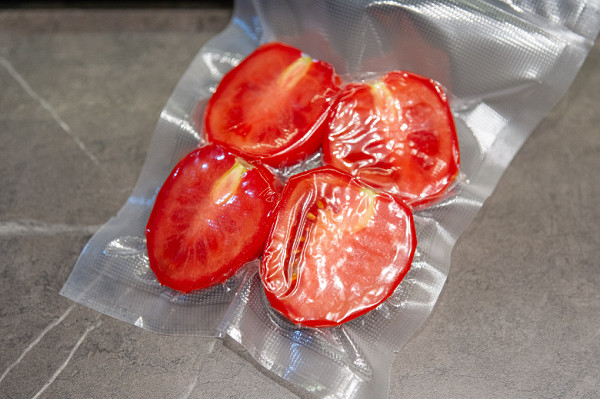
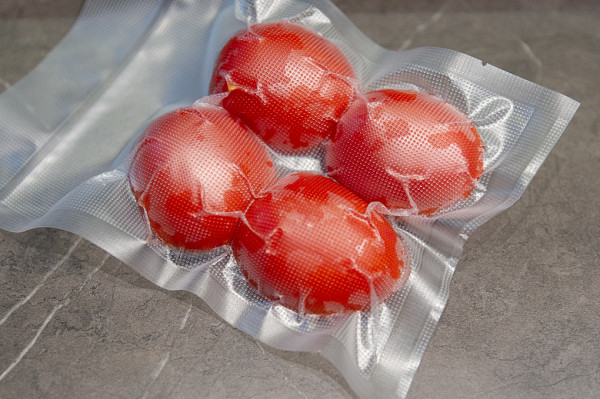
A week later, the same fresh, strong halves of tomatoes were waiting for us. The seam on the bag did not come apart, and there was no increase in air inside during storage.
Result: excellent.
Ground coffee
Finely ground coffee was poured into the bag, before placing it in the chamber, the contents were leveled, the lid was snapped on, and the mode for dry products was started.
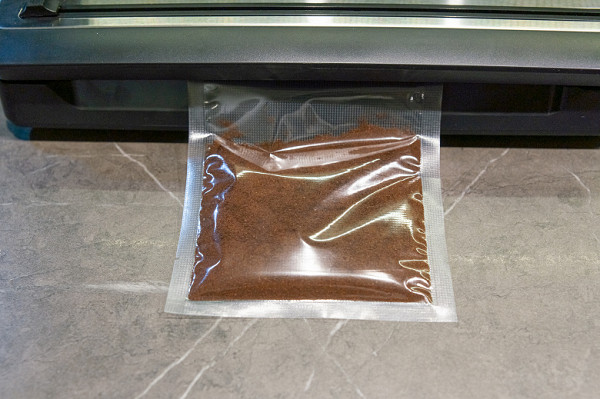
Our first priority was to find out whether the air would carry small particles of coffee with it. As you can see in the photo below, by the end of the air pumping only a small amount of particles had risen to the top, but they had not been able to rise above the sealing level.
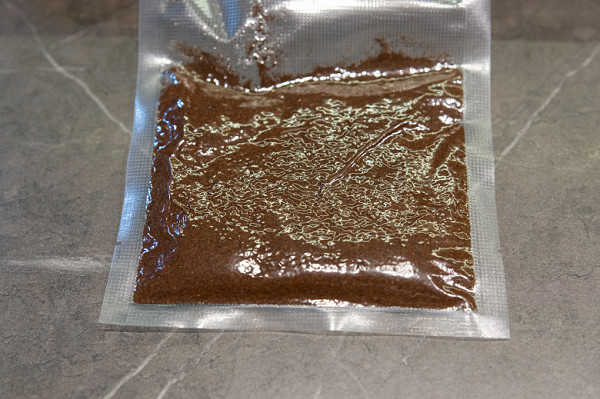
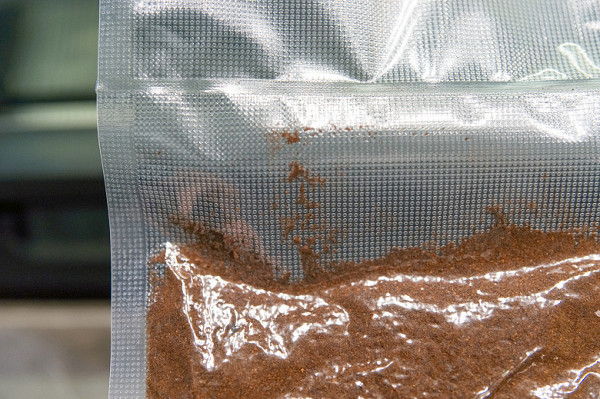
The coffee was perfectly compressed, and to check the quality of air pumping, we tapped the bag on the table and made sure that not a single grain had moved.
Result: excellent.
Meat in marinade
The future pork kebab meat was pre-soaked in the marinade for approximately 6 hours. In order not to stain the edges of the bags, we turned them inside out, then placed the meat inside, evenly distributed the onions in it and added a slice of lemon — everything in which the meat was marinated.

We could have sealed it like that, but we decided to add four tablespoons of marinade. After this, it was important to have time to press the Stop button. To tell the truth, we missed this moment the first time.
I had to remove the container, pour the liquid out of it, rinse it, return it to its place and wipe the top of the bag with a napkin. The level of marinade in the bag naturally dropped, so we added a few more spoons. The second time everything went smoothly. The air was partially pumped out, the juice did not rise to the very top, we stopped the pump in a timely manner and sealed the bag.

Result: excellent.
Oversized knitted hat
This test will allow us to clearly demonstrate how effectively the DeMak vacuum cleaner removes air from the bag.
In dry mode, the vacuum pump pumped out air for about 20-25 seconds and another 5 were spent sealing the seam.
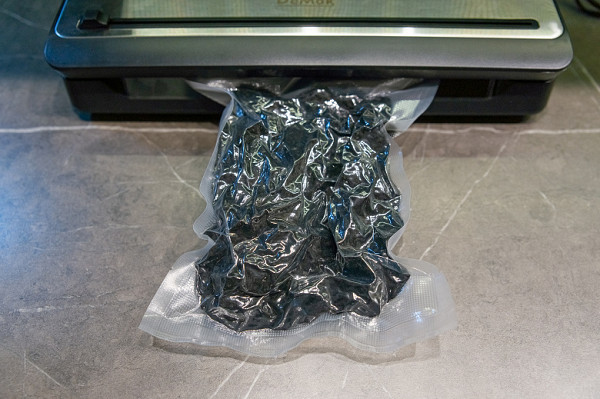
In dry mode, the vacuum pump pumped out air for about 20-25 seconds and another 5 were spent sealing the seam.
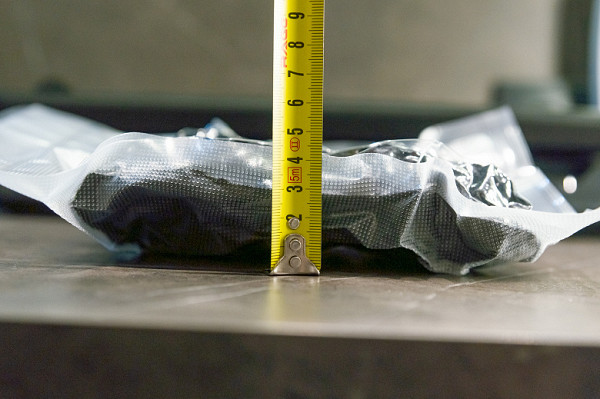
Having felt the bag, we were convinced that there was practically no air left inside.
Result: excellent.
conclusions
The DeMak VS8001 vacuum cleaner passed our practical testing, successfully performing all the stated functions. This stylish model reliably vacuum seals both dry and wet food in bags, creating a strong and even seal with a width of 4 mm. It effectively pumps air out of containers, has a sealing mode without vacuum, and also has a built-in cutter. In general, the device provides all the necessary functions for convenient and long-term storage of food and items.
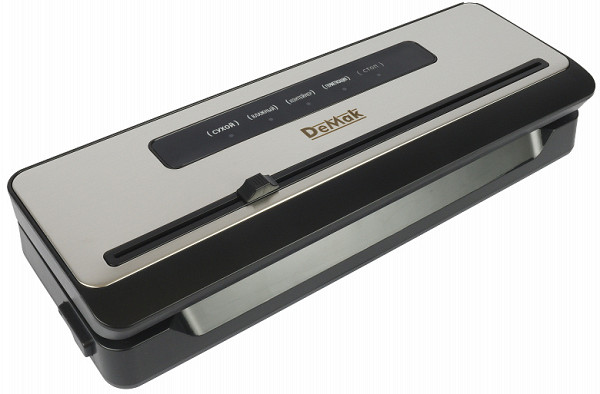
Operation of the device is simple, with a bright blue indicator that clearly displays the vacuuming stage, preventing early opening of the lid. Among the advantages, it is worth noting ease of operation and maintenance, fast and high-quality pumping of air from bags and containers, as well as a wide thermal tape (almost 32 cm). Additional benefits include a built-in cutter, a vacuum-free sealing mode and a strong 4mm seam. The option to extend the warranty to 3 years and the affordable price also add to the attractiveness of the device.
Pros:
- Easy operation and maintenance
- Effective pumping of air from bags and containers
- Wide thermal tape (almost 32 cm)
- Built-in cutter and sealing mode without pumping out air
- High-quality seam 4 mm wide
- Possibility of increasing the warranty to 3 years
Minuses:
- Difficult connection between hose and containers


